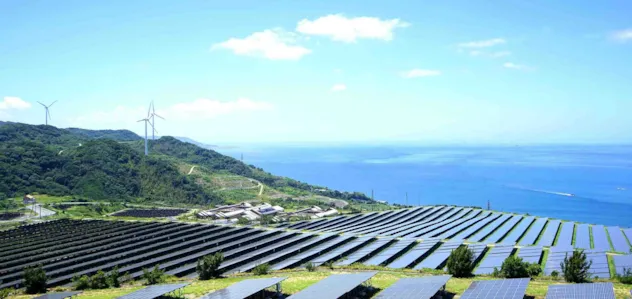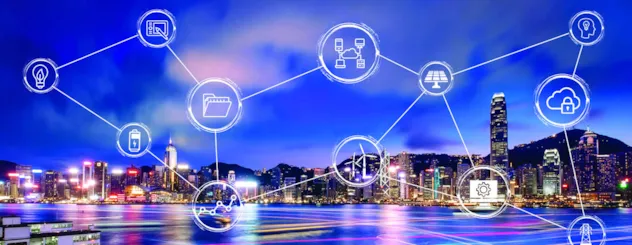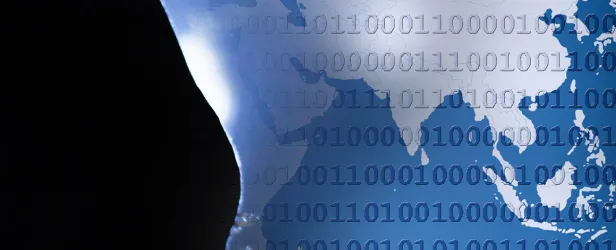December 13, 2017 | Podcast
Digitalization: the 'new industrial revolution'
Transcript:
Transcript:
NARRATOR Welcome to the DNV Talks Energy podcast series. Electrification, rise of renewables and new technologies supported by more data and IT systems are transforming the power system. Join us each week as we discuss these changes with guests from around the industry.
Transcript:
MATHIAS STECK Welcome to a new episode of DNV Talks Energy. My guest is Ansgar Hinz, CEO of VDE, and we want to talk about the energy transition, but we want to more focus about, on interconnection, digitalization, and cyber security in this aspect. But Ansgar, first of all, welcome to this podcast, and before we start, it would be great if you could introduce yourself, as a person, and tell us what VDE actually stands for.
Transcript:
00:00:50
Transcript:
ANSGAR HINZ Okay, try to. First of all, thank you very much for the invitation. Well, I, personally, I’m an electrical engineer, so I’ve grown up in electric energy business for 23 years. I was working for a huge group dealing with control and monitoring and regulating of energy grids worldwide, and energy grids are mostly different in different countries around the globe. And this was mainly my task.
And well, roughly two years ago there was an ask from VDE, “could you imagine to bring in your knowledge into VDE?” And after a long discussion, I said, “Well, there is a big challenge, the challenges you talked during your introduction”, and so, I became CEO at the beginning of 2016. VDE. What is VDE? VDE is in Europe the association for electrical, electronic, and information technology. We have roughly 36,000 members led by personal members, industrial companies, R&D segments of companies, and we are more than 250,000 universities building up this knowledge group.
Transcript:
MATHIAS STECK Right, so let’s jump into the topic. The transition of the electric or electricity ecosystem, let’s call it like this, is mainly also relying on digitalization. There will much more assets connected to the grid, which are intelligently communicating with the grid. But that comes also with all kinds of complexities, so at the moment we see a lot of different IoT platforms coming up from different manufacturers. So, we will have to overcome the complexity of these platforms all talking to each other. What is your hunch on that?
Transcript:
00:02:38
Transcript:
ANSGAR HINZ Well, like a medal, there are two sides. On the one hand, personally, as an electrical engineer, I’m totally thrilled by the decade we are living in and we are working in. I compared that, during the morning on a panel session we had, with the, let me say, eighteenth century, where the steam-driven engines have been transformed into electrical-driven engines, which was totally a change in industrial production. And then, well, we ran through a process of improvement, of evolution, sometimes revolution, but nowadays I would say we can compare that. It’s a transition period, not only in the energy business, also the industrial business and other market segments.
And the other side of the medal is digitalization. Well, what is it? I am astounded sometimes because it’s not new. We were talking about digitalization in the 60s and the 70s and the 80s. Digitalization is a method, out of my interpretation. It’s not the instrument. There are several instruments, and if you put them together in a basket, you can talk about a period of digitalization. But the sense in it and the instruments have been different in the 60s, the 70s, and today they are different. But you are right in what you describe: digitalization is—well, let me say—a method enabling the future perspective and future structure of energy grids.
Transcript:
MATHIAS STECK Yes, and I’m with you on this digital aspect. But I think the interconnectivity and the integration is now what is enabled, because the systems have become so powerful, right, and this is why we have new challenges, which we maybe didn’t have in the 60s.
Transcript:
00:04:25
Transcript:
ANSGAR HINZ Absolutely. I think you’re aware of that; the traditional structure of an energy grid was a top-down structure. Actually, by the volatile infeed of renewable energy, PV or wind energy, biogas, in the mid-voltage / in the low-voltage segment, the top-down structure doesn’t even longer fit. You cannot even longer manage and monitor grids in the traditional top-down way, because the volatile infeed mostly happens on the mid-voltage and low-voltage level. And the need for interconnection of grids, local grids, or interconnection to balance is of more interest than in the past.
Transcript:
MATHIAS STECK Right, and so, listening also to what other colleagues on your panel said today, I think there is good technology out there already on the smart meter side or whatever. But there’s much more we could maybe do. Going, like, next generation, one step ahead, I think there’s also some expectation that any processes in the grid later might be managed not necessarily by humans any more, but by processes, like machine-learning processes maybe, which optimize how the grid is operated from generation to the load.
Transcript:
00:06:34
Transcript:
And then we’re entering in an era which is certainly very comfortable and very efficient, but we also open up to some sort of vulnerability. So, what I’m getting at is, with all these advancements, we’re getting into an era where we have a challenge of cyber security, and I think we see some examples; and it would be great to hear from you what the challenges are today. But I would extremely also be interested in your outlook, where you see that going, and then we can maybe in a second question discuss what we can do against it. But I would be really interested on your view on that cyber security topic in the environment you just described.
Transcript:
ANSGAR HINZ I’m 100% with you. In the mid-term perspective, it’s both: on the one hand, human control of systems, but on the other hand, the implementation of KI, so, automated systems, machine-learning systems which are able to manage the one or the other, structural monitoring of grids or parts of grids. So, with the implementation of more and more sensors, and we are estimating in 2030 more than 100 trillion sensors in all market segments, the increase of data management follows nearby.
So, the question is, on the one hand, how to manage this volume, this mass of data; on the other hand, how to make it secure in strong correlation to the increase of the number of sensors in an electrical grid. Assumptions say that in 2030 we will have more 100 trillion sensors, not only in energy grids, but in the total number of market segments. The increase of data, of volume of data is strongly correlated with that. So, how to handle that? I’m personally a fan of, to structure a problem in the right way.
Transcript:
00:08:37
Transcript:
So, what are the four elements? The first element definitely is the technology side, so, it’s hardware, it’s software, it’s firmware, the intelligent sensor itself, and the technology how to collect data. Second segment is the semantic, so, we need to develop - And there are actually investigations to develop something. We need to develop a common language, a common language of machines, a common language of describing functions of sensors and systems, a component in a system.
And third part is communication, so, we need to define for cyber security risks and emergency events. We need a new way of communication over countries from government to government, from country to country. For example, in natural crime we have that. It’s called Interpol, so, there must be something in this way too. It’s not only a technical question, it’s also a society question. And this is the thrill for the future, to structurize the problem and to find individual solutions, and at the end we combine that to a system solution.
Transcript:
MATHIAS STECK Yes, so, I mean, this aspect, Interpol, is an interesting one. I think the one issue we have that cyber security is kind of a bit higher up than the individual’s crime, because it could, in the worst-case scenario, be governments using that as a weapon, and I think many armies are actually gearing up for this. So, I guess cooperation on international levels will be very important to make this whole journey a success.
Transcript:
00:10:29
Transcript:
ANSGAR HINZ Absolutely, and you’re describing a simple matrix. On the x axis you have the hardware, you have the environment, you have the human behaviour, you have software aspect and data protection aspect. And on the y angle , you have the different levels of aggressors from, let me say, from kids to government. And in between, there’re several other groups of aggressors. And they have different types of motivations. And on the other hand, you have the different fields of places where you can aggress or enter into a system. And if you fill this matrix with different types of reaction mechanisms and methods, you have a kind of, let me say, guideline or road map how to react on different levels against cybersecurity issues. In VDE, for example, we have built up a CERT team. It’s a computer emergency response team acting on different levels if we have an aggress from the outside.
Transcript:
MATHIAS STECK That’s for your own protection?
Transcript:
ANSGAR HINZ It’s for own protection, but it’s also for membership in the organization; and you can as a company, for example, enter this team. It’s a closed team, where we discuss without sending out information into the public issues, inside a company of these partners, which we put together in this team. It’s very trustful, let me say, membership, close d-membership organization to avoid that there are bigger issues on the production side of the industrial partners.
Transcript:
00:12:12
Transcript:
MATHIAS STECK I see. So, looking ahead, there’s other new technologies; I think some are already around the corner. We hear a lot about blockchain, which is basically kind of a system of trust without any intermediaries. We’re sharing things pretty much in the public. We have quantum computing coming up, which promises us maybe much higher encryption levels than we can dream of today. Do you think cyber is a temporary problem, or is it something which is the new normal and we just have to live with that?
Transcript:
ANSGAR HINZ Well, it depends on what you mean with temporary problem. If we’re talking about a couple of months, I would say no. If we are talking about the next five, eight, and I would say ten years, I definitely would say no, with a slightly maybe yes on the long run. Well, let’s see, more than 20, 10 years. I don’t want to look into the future, but on the mid, on the short one, I would say, you talked about blockchain. Well, I think there we are, in a period of implementation of test beds. You heard that in, during a panel this morning, that there is a test bed. Siemens built up one…
Transcript:
00:13:31
Transcript:
MATHIAS STECK Yes, that’s right.
Transcript:
ANSGAR HINZ In New York. But they are, as around the globe, there we have a perspective, I would say, the next three to five years to have a blockchain as a partly solution of, for one or the other IT security risks. On the other hand, you mention, on the technology side, quantum computers. We have one special society inside VDE.
It’s dealing with micro system technology and sensor technology; and they are deeply involved in the technical development of quantum computers. Their perspective is that during the next 10 years, 10–12 years, we will not see a scalable mass of quantum computers or computers or communication systems based on quantum technology. So I would say, on the mid-run, when we’re talking about a perspective of eight to ten years, we have to deal with cyber security risk.
Transcript:
MATHIAS STECK So, slowly we’re coming, unfortunately, to an end of this episode, but one thing I want to ask, because we’re both in the business, how important are standards in the future to deal with these things?
Transcript:
ANSGAR HINZ
Transcript:
MATHIAS STECK Yes, that’s right.
Transcript:
ANSGAR HINZ How much time do we have today? Out of my perspective, and I think you of my opinion too, it’s essential. As more complex systems get, as more you have to have standards on different level to, on the one hand, enable and simplify communication; to, yes, address quality; to address safety for the society and the individuals; as a new factor, to address and standardize security issues, we talked about cyber security; and, last but not least, to walk the way of transition from proprietary solutions into open-source solutions and technologies.
Transcript:
00:15:40
Transcript:
And this is independently from the market segment we are in, the way we have to deal with in the present, in the near future, and in the long future. The time, out of my perspective, this is a personal opinion; the time is over that, for example, one company gets the whole cake. We have to build up, in order to avoid risks on safety and security side, ecosystems where we share our knowledge and where we share our, results and success.
Transcript:
MATHIAS STECK Right, so the last question I shoot at you is, “What is your main takeaway from Singapore’s International Energy Week 2017?”
Transcript:
ANSGAR HINZ Compared to last year, for example, I mentioned that, during another interview during the day, this year I see green fields. Last year we tried to prepare everything for growth of plants, green plants, and actually I see the first green fields, which we worked on during the last 12 months. And I’m absolutely astonished how all the participants and members of the association were very focused on the different fields of future technologies in the segment of green energy, not only in the segment, but especially in the segment, but also reflecting—this was part of our meeting today—additional aspects like digitalization and IT security risks.
Transcript:
00:17:15
Transcript:
We cannot even longer have a look at separately. We have to combine that out of the system perspective; and I’m absolutely grateful that we could’ve been there, here presenting our knowledge, being part of the show, and hopefully we will see in 2018 not only one field of green plants, but maybe 10, 15, or 100.
Transcript:
MATHIAS STECK I agree. Thank you very much Ansgar for your…
Transcript:
ANSGAR HINZ It was my pleasure.
Transcript:
MATHIAS STECK insight, for your time.
Transcript:
ANSGAR HINZ Thank you.
Transcript:
MATHIAS STECK And to the audience, thank you very much for listening in. That was Ansgar Hinz, CEO of VDE.
Transcript:
NARRATOR Thank you for listening to this DNV Talks Energy podcast. To hear more podcasts in the series, please visit dnvgl.com/talksenergy.
Transcript:
00:18:05


